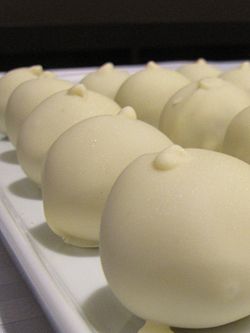Cake balls
Cake balls are small spheres of reconstituted cake crumbs, coated with chocolate or frosting. They are made by blending cake crumbs with icing, shaping them to form a ball and then dipping them in a coating, such as melted chocolate. Cake balls were originally created from the crumbs of leftover or stale cake to prevent waste. Cake balls do not have the consistency of the traditional sweetened, baked and leavened cakes, but have a consistency similar to dough which can be attributed to the blending of the cake crumbs and icing. Cake balls are sold in various bakeries as well as mall kiosks; they are also available to be purchased as gifts. The bite-sized snacks may be displayed on a stick (known as a cake pop), and can be decorated with ribbon. They are especially popular during the holiday months. Cake balls can be decorated with toppings in a variety of ways, using such items as sprinkles, nuts, chocolate shavings, candy, other confectionery toppings, to name a few. Almond bark or confectionery coating are often used as alternatives to chocolate, and can be easily melted in a microwave oven before dipping. Vegan and gluten-free cake balls also exist.Icing, also called frosting in the United States, is a sweet often creamy glaze made of sugar with a liquid, such as water or milk, that is often enriched with ingredients such as butter, egg whites, cream cheese, or flavorings. It is used to cover or decorate baked goods, such as cakes or cookies. Elizabeth Raffald documented the first recipe for icing in 1769 in the Experienced English Housekeeper, according to the Food Timeline. However, it was not until 1915 that Mrs. Fred W. Gurney created the first buttercream recipe, and Fannie Farmer followed suit with several more recipes in 1918 and 1923.[1] Icing can be formed into shapes such as flowers and leaves using a pastry bag. Such decorations are common place on birthday and wedding cakes. Chef's color dye (food coloring) is commonly added to icing mixtures to achieve the desired color. Sprinkles, coloring mist, edible ink designs, or other decorations are often used on top of icing. The simplest icing is a glace icing, containing powdered sugar and water. This can be flavored and colored

s desired, for example, by using lemon juice in place of the water. More complicated icings can be made by beating fat into powdered sugar (as in buttercream), by melting fat and sugar together, by using egg whites (as in royal icing), and by adding other ingredients such as glycerin (as in fondant). Some icings can be made from combinations of sugar and cream cheese or sour cream, or by using ground almonds (as in marzipan). Icing can be applied with a utensil such as a knife or spatula, or it can be applied by drizzling or dipping (see glaze), or by rolling the icing out and draping it over the cake. The method of application largely depends on the type and texture of icing being used. Icing may be used between layers in a cake as a filling, or it may be used to completely or partially cover the outside of a cake or other baked product.Chocolate i/?tkl?t/ is a raw or processed food produced from the seed of the tropical Theobroma cacao tree. Cacao has been cultivated for at least three millennia in Mexico, Central America and Northern South America. Its earliest documented use is around 1100 BC. The majority of the Mesoamerican people made chocolate beverages, including the Aztecs, who made it into a beverage known as xocolatl [?o'kola?t], a Nahuatl word meaning "bitter water". The seeds of the cacao tree have an intense bitter taste, and Moussest be fermented to develop the flavor. After fermentation, the beans are dried, then cleaned, and then roasted, and the shell is removed to produce cacao nibs. The nibs are then ground to cocoa mass, pure chocolate in rough form. Because this cocoa mass usually is liquefied then molded with or without other ingredients, it is called chocolate liquor. The liquor also may be processed into two components: cocoa solids and cocoa butter. Unsweetened baking chocolate (bitter chocolate) contains primarily cocoa solids and cocoa butter in varying proportions. Much of the chocolate consumed today is in the form of sweet chocolate, combining cocoa solids, cocoa butter or other fat, and sugar. Milk chocolate is sweet chocolate that additionally contains milk powder or condensed milk. White chocolate contains cocoa butter, sugar, and milk but no cocoa solids.